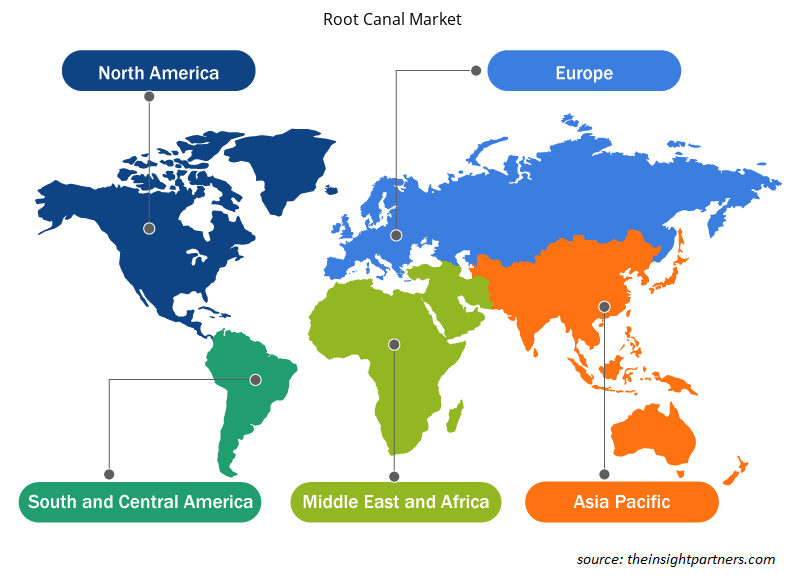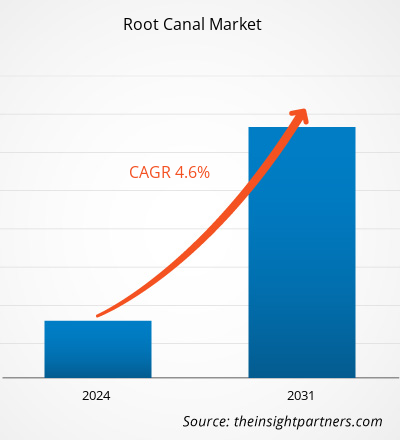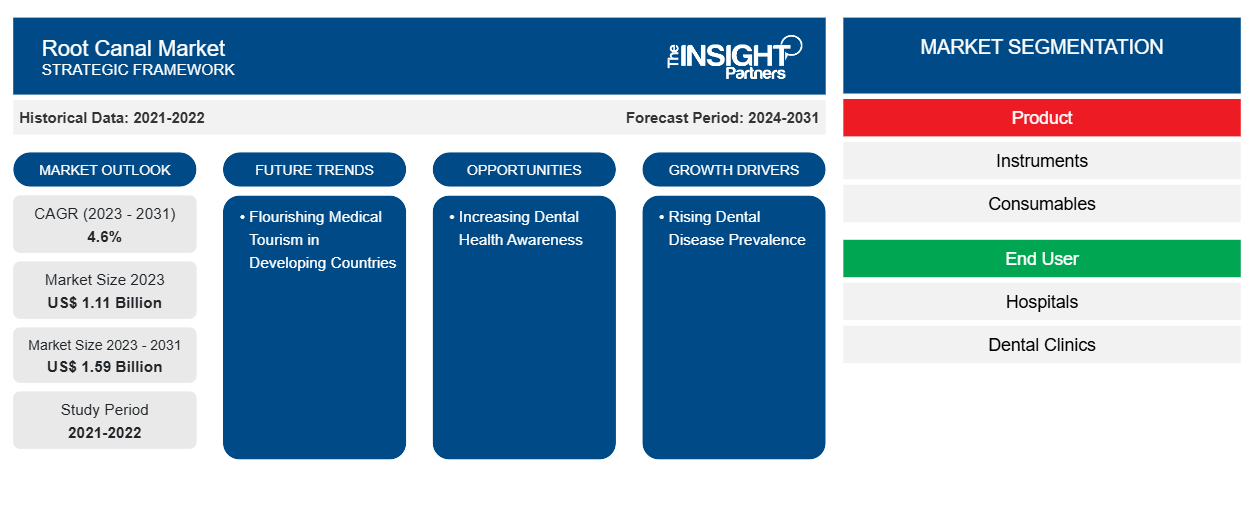Si prevede che la dimensione del mercato dei canali radicolari raggiungerà 1,59 miliardi di dollari entro il 2031 da 1,11 miliardi di dollari nel 2023. Si prevede che il mercato registrerà un CAGR del 4,6% nel periodo 2023-2031. I miglioramenti tecnici che si traducono nello sviluppo di nuovi design rivoluzionari di lime, come le lime in nichel-titanio stampate in 3D con maggiore flessibilità, resistenza alla fatica e alla frattura e capacità di debridement del canale, rimarranno probabilmente una tendenza chiave nel mercato dei canali radicolari.
Analisi del mercato della terapia canalare
Fattori come la crescente prevalenza di malattie dentali, la crescita della popolazione geriatrica e la crescente consapevolezza della salute dentale stanno guidando la crescita del mercato. Inoltre, l'aumento delle persone che si rivolgono alle economie emergenti per le procedure odontoiatriche sta offrendo opportunità significative per la crescita futura degli operatori del mercato della devitalizzazione.
Panoramica del mercato della terapia canalare
Il trattamento canalare mira a ridurre o sradicare i batteri da un canale radicolare infetto, evitare una reinfezione e salvare il dente originale. Dolore, sensazione di calore e gonfiore gengivale sono frequenti indicazioni di danni alla polpa nel dente. Un trattamento canalare comporta la rimozione della polpa infiammatoria o infetta, nonché l'attenta pulizia e disinfezione del dente, seguita da otturazione e sigillatura.
Personalizza questo report in base alle tue esigenze
Riceverai la personalizzazione gratuita di qualsiasi report, comprese parti di questo report, o analisi a livello nazionale, pacchetto dati Excel, oltre a usufruire di grandi offerte e sconti per start-up e università
-
Scopri le principali tendenze di mercato in questo rapporto.Questo campione GRATUITO includerà analisi di dati che spaziano dalle tendenze di mercato alle stime e alle previsioni.
Driver e opportunità del mercato della terapia canalare
La crescente consapevolezza della salute dentale favorisce la crescita del mercato
La maggior parte della popolazione mondiale non preferisce andare dal dentista a causa degli elevati costi delle cure. Inoltre, l'accesso alle cure dentistiche è un po' difficile in quanto è generalmente coperto dal settore sanitario privato. La maggior parte delle condizioni dentali sono prevenibili e condividono fattori di rischio comuni con altre malattie croniche . Pertanto, c'è un'elevata negligenza verso questi problemi tra le persone. Inoltre, i determinanti sociali della salute come reddito, occupazione e istruzione hanno un impatto anche sulle condizioni di salute. Inoltre, le popolazioni residenti nelle aree rurali non sono a conoscenza dell'igiene dentale, della salute dentale e delle malattie. Vari governi in tutto il mondo stanno supportando le comunità di istruzione e consapevolezza sulla salute orale. Negli Stati Uniti, l'American Dental Association ha annunciato febbraio come il mese nazionale della salute dentale dei bambini. Ha implementato un programma di benessere dentale nel 2019; il programma riunisce diversi operatori sanitari, professionisti dentali ed educatori per promuovere i vantaggi di una buona salute orale per i bambini e i loro assistenti, compresi gli insegnanti. Allo stesso modo, in India, il National Oral Health Program è stato avviato dall'Indian Dental Association (IDA) nel 2020, per affrontare efficacemente il peso delle malattie dentali. Pertanto, il crescente numero di programmi di sensibilizzazione sta incrementando la domanda di procedure di devitalizzazione, favorendo così la crescita del mercato.
Il turismo medico in crescita nei paesi in via di sviluppo creerà notevoli opportunità in futuro
Il turismo medico comporta l'approccio ai sistemi sanitari esteri per ottenere servizi efficaci a costi ridotti. La maggior parte dei creatori di annunci di turismo dentale si rivolge agli americani che cercano cure in Messico o Costa Rica, così come agli australiani che cercano cure in Thailandia, Corea del Sud e India. Il turismo dentale sta diventando una parte sempre più significativa del business del turismo medico. Inoltre, la Turchia è una destinazione popolare per il turismo dentale, in particolare tra gli europei. A Istanbul, le persone possono risparmiare fino al 75% sulle cure dentistiche mentre si godono pacchetti vacanze. In Turchia, un intervento di devitalizzazione costa appena 150 $ USA, che negli Stati Uniti possono arrivare fino a 1.000 $ USA. Inoltre, il trattamento prevede l'uso delle tecnologie più avanzate. Pertanto, l'aumento delle persone che si rivolgono alle economie emergenti per le procedure dentali sta offrendo opportunità significative per la crescita futura degli operatori del mercato della devitalizzazione.
Analisi della segmentazione del rapporto di mercato del canale radicolare
I segmenti chiave che hanno contribuito alla derivazione dell'analisi del mercato della terapia canalare sono il prodotto e l'utente finale.
- Per prodotto, il mercato è diviso in strumenti e materiali di consumo. Nel 2023, il segmento dei materiali di consumo deteneva una quota maggiore del mercato.
- In base all'utente finale, il mercato della devitalizzazione è segmentato in ospedali, cliniche odontoiatriche e altri. Nel 2023, il segmento delle cliniche odontoiatriche deteneva la quota maggiore del mercato. Si stima che il segmento ospedaliero registrerà il CAGR più elevato durante il periodo di previsione.
Analisi della quota di mercato della terapia canalare per area geografica
L'ambito geografico del rapporto sul mercato della devitalizzazione comprende cinque regioni: Nord America, Asia Pacifico, Europa, Medio Oriente e Africa e Sud e Centro America. Il Nord America ha dominato il mercato della devitalizzazione nel 2023. Il fattore chiave che sta guidando la crescita è il crescente numero di incidenze di malattie dentali e l'aumento delle iniziative governative nei paesi della regione. Inoltre, è probabile che l'espansione dell'assicurazione dentale migliori la crescita del mercato durante il periodo di previsione. Si prevede inoltre che il mercato registrerà una crescita significativa a causa del crescente turismo medico per i problemi dentali in Messico.
Approfondimenti regionali sul mercato della terapia canalare
Le tendenze regionali e i fattori che influenzano il mercato del canale radicolare durante il periodo di previsione sono stati ampiamente spiegati dagli analisti di Insight Partners. Questa sezione discute anche i segmenti e la geografia del mercato del canale radicolare in Nord America, Europa, Asia Pacifico, Medio Oriente e Africa e Sud e Centro America.

- Ottieni i dati specifici regionali per il mercato della terapia canalare
Ambito del rapporto sul mercato della terapia canalare
| Attributo del report | Dettagli |
|---|---|
| Dimensioni del mercato nel 2023 | 1,11 miliardi di dollari USA |
| Dimensioni del mercato entro il 2031 | 1,59 miliardi di dollari USA |
| CAGR globale (2023-2031) | 4,6% |
| Dati storici | 2021-2022 |
| Periodo di previsione | 2024-2031 |
| Segmenti coperti |
Per Prodotto
|
| Regioni e Paesi coperti |
America del Nord
|
| Leader di mercato e profili aziendali chiave |
|
Densità degli operatori del mercato della terapia canalare: comprendere il suo impatto sulle dinamiche aziendali
Il mercato del canale radicolare sta crescendo rapidamente, spinto dalla crescente domanda degli utenti finali dovuta a fattori quali l'evoluzione delle preferenze dei consumatori, i progressi tecnologici e una maggiore consapevolezza dei benefici del prodotto. Con l'aumento della domanda, le aziende stanno ampliando le loro offerte, innovando per soddisfare le esigenze dei consumatori e capitalizzando sulle tendenze emergenti, il che alimenta ulteriormente la crescita del mercato.
La densità degli operatori di mercato si riferisce alla distribuzione di aziende o società che operano in un particolare mercato o settore. Indica quanti concorrenti (operatori di mercato) sono presenti in un dato spazio di mercato in relazione alle sue dimensioni o al valore di mercato totale.
Le principali aziende che operano nel mercato della terapia canalare sono:
- Gruppo Coltene
- Dentsply Sirona Inc
- Società per azioni Envista
- Brasseler USA
- Gruppo Diadent Internazionale
- Gruppo Ivoclar Vivadent
Disclaimer : le aziende elencate sopra non sono classificate secondo un ordine particolare.

- Ottieni una panoramica dei principali attori del mercato della terapia canalare
Notizie e sviluppi recenti sul mercato della terapia canalare
Il mercato della devitalizzazione viene valutato raccogliendo dati qualitativi e quantitativi dopo la ricerca primaria e secondaria, che includono importanti pubblicazioni aziendali, dati associativi e database. Di seguito sono menzionati alcuni degli sviluppi chiave del mercato:
- Prime Dental, un nome rinomato nel settore dell'assistenza odontoiatrica, ha annunciato il lancio dei suoi servizi di sbiancamento dei denti all'avanguardia a Mount Pleasant. Con l'impegno di fornire soluzioni odontoiatriche eccezionali, Prime Dental è pronta a rivoluzionare i sorrisi e ad aumentare i livelli di sicurezza dei residenti nell'area di Mount Pleasant. (per il comunicato stampa, Newsletter, marzo 2024)
Copertura e risultati del rapporto sul mercato della terapia canalare
Il rapporto "Dimensioni e previsioni del mercato del canale radicolare (2021-2031)" fornisce un'analisi dettagliata del mercato che copre le seguenti aree:
- Dimensioni e previsioni del mercato della terapia canalare a livello globale, regionale e nazionale per tutti i principali segmenti di mercato coperti dall'ambito
- Tendenze del mercato della terapia canalare e dinamiche di mercato come fattori trainanti, vincoli e opportunità chiave
- Analisi dettagliata delle cinque forze PEST/Porter e SWOT
- Analisi del mercato della terapia canalare che copre le principali tendenze del mercato, il quadro globale e regionale, i principali attori, le normative e i recenti sviluppi del mercato
- Analisi del panorama industriale e della concorrenza che copre la concentrazione del mercato, l'analisi della mappa di calore, i principali attori e gli sviluppi recenti per il mercato della terapia canalare
- Profili aziendali dettagliati
- Analisi storica (2 anni), anno base, previsione (7 anni) con CAGR
- Analisi PEST e SWOT
- Valore/volume delle dimensioni del mercato - Globale, Regionale, Nazionale
- Industria e panorama competitivo
- Set di dati Excel
Report recenti
Testimonianze
Motivo dell'acquisto
- Processo decisionale informato
- Comprensione delle dinamiche di mercato
- Analisi competitiva
- Analisi dei clienti
- Previsioni di mercato
- Mitigazione del rischio
- Pianificazione strategica
- Giustificazione degli investimenti
- Identificazione dei mercati emergenti
- Miglioramento delle strategie di marketing
- Aumento dell'efficienza operativa
- Allineamento alle tendenze normative























 Ottieni un campione gratuito per - Mercato della devitalizzazione
Ottieni un campione gratuito per - Mercato della devitalizzazione